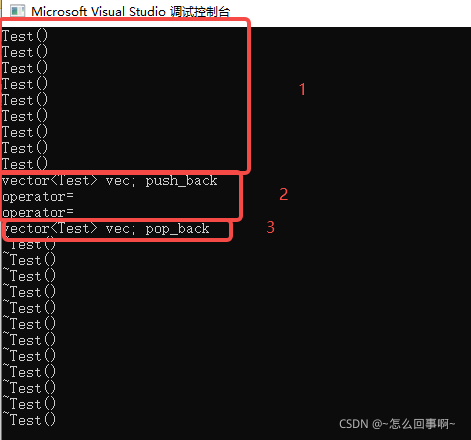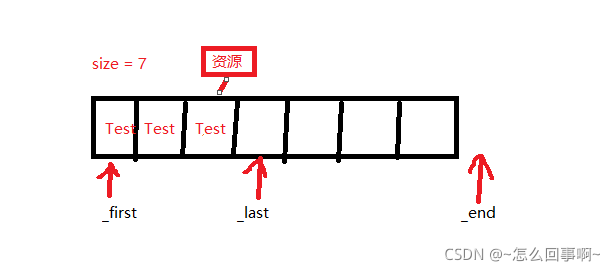 关于“基于C语言怎样实现Vector,过程是什么”的知识点有一些人不是很理解,对此小编给大家总结了相关内容,文中的内容简单清晰,易于学习与理解,具有一定的参考学习价值,希望能对大家有所帮助,接下来就跟随小编一起学习一下“基于C语言怎样实现Vector,过程是什么”吧。
关于“基于C语言怎样实现Vector,过程是什么”的知识点有一些人不是很理解,对此小编给大家总结了相关内容,文中的内容简单清晰,易于学习与理解,具有一定的参考学习价值,希望能对大家有所帮助,接下来就跟随小编一起学习一下“基于C语言怎样实现Vector,过程是什么”吧。函数模板
函数模板:是不进行编译的,因为类型还不知道
模板的实例化:函数调用点进行实例化
模板函数:才是要被编译器所编译的
模板类型参数:typyname/class
模板非类型参数:模板非类型形参的详细阐述
模板的实参推演:可以根据用户传入的实参的类型,来推导出模板类型参数的具体
模板的特例化(专用化)的实例化
模板函数、模板的特例化和非模板函数的重载关系:候选的函数中,优先在精确匹配中选择,优先选择普通函数,特例性更强的模版函数次之,然后是模版函数的特化版本,最后才是泛化版本。
模板代码是不能声明在.h,实现在.cpp,模板代码调用之前,一定要看到模板定义的地方,这样的话,模板才能够正常的实例化,产生能够被编译器编译的代码。模板代码都是放在头文件中,然后在源文件中直接进行#include
#define _CRT_SECURE_NO_WARNINGS
#include <iostream>
//函数模板
template<typename T> //定义一个模板参数列表
bool compare(T a, T b) {//compare 是一个函数模板
std::cout << "template compare\n";
return a > b;
}
/*
在函数调用点,编译器用用户指定的类型,从原模板实例化一份函数代码出来:
模板函数:
bool compare<int>(int a, int b) {
return a > b;
}
bool compare<double>(double a, double b) {
return a > b;
}
*/
//模板特例化: 针对compare函数模板,提供const char * 类型的特例化版本
template<>
bool compare<const char *>(const char* a, const char * b) {
std::cout << "const char * compare\n";
return strcmp(a, b) > 0;
}
//非模板函数,普通函数
bool compare(const char* a, const char * b) {
std::cout << "normal compare\n";
return strcmp(a, b) > 0;
}
int main()
{
std::cout << compare<int>(1, 2) << std::endl;
std::cout << compare<double>(1, 2) << std::endl;
std::cout << compare(1, 2) << std::endl;//模板的实参推演 可以根据用户传入的实参的类型,来推导模板类型参数
//编译器优先把compare处理成函数名,没有的话,才去找compare模板
std::cout << compare("a", "b") << std::endl;//
return 0;
}
类模板
实现一个顺序栈
#define _CRT_SECURE_NO_WARNINGS
#include <iostream>
template<typename T>
class SeqStack
{
public:
//构造和析构函数名不加<T> 其他出现模板的地方都加上类型参数列表
SeqStack(int size = 10)
:pstack_(new T[size])
,top_(0)
,size_(size){
//初始化生成的指令更少,效率更高。仅调用默认构造函数(如果存在类成员)。赋值需要调用默认构造函数和赋值运算符
}
~SeqStack() {
if (pstack_) {
delete[] pstack_;
pstack_ = nullptr;
}
}
SeqStack(const SeqStack<T>& stack)
:top_(stack.top_),
size_(stack.size_){
pstack_ = new T[stack.size_];
for (int i = 0; i < top_; ++i) {
pstack_[i] = stack.pstack_[i];
}
}
SeqStack<T>& operator=(const SeqStack<T>&stack) {
if (this == &stack) {
return *this;
}
delete[] pstack_;
top_ = stack.top_;
size_ = stack.size_;
pstack_ = new T[stack.size_];
for (int i = 0; i < top_; ++i) {
pstack_[i] = stack.pstack_[i];
}
}
void push(const T& val) {
if (full()) {
resize();
}
pstack_[top_] = val;
top_++;
}
void pop() {
if (empty()) {
return;
}
top_--;
}
T top() const {
if (empty()) {
throw "stack is empty";
}
return pstack_[top_-1];
}
bool full() const {
return top_ == size_;
}
bool empty() const {
return top_ == 0;
}
protected:
private:
void resize() {
T * p = new T[size_ * 2];
for (int i = 0; i < top_; ++i) {
p[i] = pstack_[i];
}
size_ *= 2;
delete pstack_;
pstack_ = p;
}
T * pstack_;
int top_;
int size_;
};
int main()
{
SeqStack<int> stack;
for (int i = 0; i < 8; ++i) {
stack.push(i);
}
while (!stack.empty())
{
std::cout << stack.top() << " ";
stack.pop();
}
return 0;
}
Vector实现

vector 的本质是一个数组,在vector 中需要有三个指针:
_first :指向数组的起始位置
_last:指向已经存放的最后一个元素的下一个位置
_end:指向数组长度的末尾元素的下一个位置。
数组的容量=_end-_first
数组中存放的元素个数=_last-_first
数组是否为空:_first == _last
数组是否已满:_last == _end
简单的类模板实现代码及测试:
#define _CRT_SECURE_NO_WARNINGS
#include <iostream>
template<typename T>
class vector
{
public:
vector(int size = 10)
{
_first = new T[size];
_last = _first;
_end = _first + size;
}
~vector()
{
delete[]_first;
_first = _end = _last = nullptr;
}
vector(const vector<T>& rhs)
{
int size = rhs._end - rhs._first;
_first = new T[size];
int len = rhs._last - rhs._first;
for (int i = 0; i < len; ++i)
{
_first[i] = rhs._first[i];
}
_last = _first + len;
_end = _first + size;
}
vector<T>& operator=(const vector<T>& rhs)
{
if (this == &rhs)
return *this;
delete[]_first;
int size = rhs._end - rhs._first;
_first = new T[size];
int len = rhs._last - rhs._first;
for (int i = 0; i < len; ++i)
{
_first[i] = rhs._first[i];
}
_last = _first + len;
_end = _first + size;
return *this;
}
void push_back(const T& val) // 向容器末尾添加元素
{
if (full())
expand();
*_last++ = val;
}
void pop_back() // 从容器末尾删除元素
{
if (empty())
return;
--_last;
}
T back()const // 返回容器末尾的元素的值
{
return *(_last - 1);
}
bool full()const { return _last == _end; }
bool empty()const { return _first == _last; }
int size()const { return _last - _first; }
private:
T* _first; // 指向数组起始的位置
T* _last; // 指向数组中有效元素的后继位置
T* _end; // 指向数组空间的后继位置
void expand() // 容器的二倍扩容
{
int size = _end - _first;
T *ptmp = new T[2 * size];
for (int i = 0; i < size; ++i)
{
ptmp[i] = _first[i];
}
delete[]_first;
_first = ptmp;
_last = _first + size;
_end = _first + 2 * size;
}
};
class Test
{
public:
Test() { std::cout << "Test()" << std::endl; }
Test& operator=(const Test&t) { std::cout << "operator=" << std::endl; return *this; }
~Test() { std::cout << "~Test()" << std::endl; }
Test(const Test&) { std::cout << "Test(const Test&)" << std::endl; }
};
int main()
{
Test t1, t2;
std::cout << "vector<Test> vec" << std::endl;
vector<Test> vec;
std::cout << "vector<Test> vec; push_back" << std::endl;
vec.push_back(t1);
vec.push_back(t2);
std::cout << "vector<Test> vec; pop_back" << std::endl;
vec.pop_back();
return 0;
}

问题:在我们实现的vector构造函数中,使用new T[size] :它做了两件事情
(1)开辟内存空间
(2)调用T类型的默认构造函数构造对象
其中第二步是一种浪费,因为我还没在vector 添加元素,提前构造一遍对象 然后在析构时候是否纯属多余。
同时:在实现pop_back()时,存在内存泄漏
void pop_back() // 从容器末尾删除元素
{
if (empty())
return;
--_last;
}
T
仅仅将_last指针 --,并没有释放Test申请的资源。需要调用对象的析构函数
win msvc编译器的实现:

// CLASS TEMPLATE vector
template<class _Ty,
class _Alloc = allocator<_Ty>>
class vector
: public _Vector_alloc<_Vec_base_types<_Ty, _Alloc>>
{ // varying size array of values
private:
using _Mybase = _Vector_alloc<_Vec_base_types<_Ty, _Alloc>>;
using _Alty = typename _Mybase::_Alty;
using _Alty_traits = typename _Mybase::_Alty_traits;
......
系统的实现,除了数据类型外,还有一个allocator,它将开辟空间和构造对象分离开。
而这,也就是空间配置器做的工作;
容器的空间配置器
空间配置器主要有四个功能:
- 内存开辟 allocate(底层调用malloc);
- 内存释放 deallocate(底层调用free);
- 对象构造 construct(调用构造函数);
- 对象析构 destroy(调用析构函数
// 定义容器的空间配置器,和C++标准库的allocator实现一样
template<typename T>
struct Allocator
{
T* allocate(size_t size) // 负责内存开辟
{
return (T*)malloc(sizeof(T) * size);
}
void deallocate(void* p) // 负责内存释放
{
free(p);
}
void construct(T* p, const T& val) // 负责对象构造
{
new (p) T(val); // 定位new
}
void destroy(T* p) // 负责对象析构
{
p->~T(); // ~T()代表了T类型的析构函数
}
};
修改后的vector
#include <iostream>
// 定义容器的空间配置器,和C++标准库的allocator实现一样
template<typename T>
class Allocator
{
public:
T* allocate(size_t size) // 负责内存开辟
{
return (T*)malloc(sizeof(T) * size);
}
void deallocate(void* p) // 负责内存释放
{
free(p);
}
void construct(T* p, const T& val) // 负责对象构造
{
new (p) T(val); // 定位new
}
void destroy(T* p) // 负责对象析构
{
p->~T(); // ~T()代表了T类型的析构函数
}
};
template<typename T, typename Alloc = Allocator<T>>
class vector
{
public:
vector(int size = 10)
{
// 需要把内存开辟和对象构造分开处理
_first = _allocator.allocate(size);
_last = _first;
_end = _first + size;
}
~vector()
{
// 析构容器有效的元素,然后释放_first指针指向的堆内存
for (T* p = _first; p != _last; ++p)
{
_allocator.destroy(p); // 把_first指针指向的数组的有效元素进行析构操作
}
_allocator.deallocate(_first); // 释放堆上的数组内存
_first = _last = _end = nullptr;
}
vector(const vector<T>& rhs)
{
int size = rhs._end - rhs._first;
_first = _allocator.allocate(size);
int len = rhs._last - rhs._first;
for (int i = 0; i < len; ++i)
{
_allocator.construct(_first + i, rhs._first[i]);
}
_last = _first + len;
_end = _first + size;
}
vector<T>& operator=(const vector<T>& rhs)
{
if (this == &rhs)
return *this;
for (T* p = _first; p != _last; ++p)
{
_allocator.destroy(p); // 把_first指针指向的数组的有效元素进行析构操作
}
_allocator.deallocate(_first);
int size = rhs._end - rhs._first;
_first = _allocator.allocate(size);
int len = rhs._last - rhs._first;
for (int i = 0; i < len; ++i)
{
_allocator.construct(_first + i, rhs._first[i]);
}
_last = _first + len;
_end = _first + size;
return *this;
}
void push_back(const T& val) // 向容器末尾添加元素
{
if (full())
expand();
_allocator.construct(_last, val);
_last++;
}
void pop_back() // 从容器末尾删除元素
{
if (empty())
return;
// 不仅要把_last指针--,还需要析构删除的元素
--_last;
_allocator.destroy(_last);
}
T back()const // 返回容器末尾的元素的值
{
return *(_last - 1);
}
bool full()const { return _last == _end; }
bool empty()const { return _first == _last; }
int size()const { return _last - _first; }
private:
T* _first; // 指向数组起始的位置
T* _last; // 指向数组中有效元素的后继位置
T* _end; // 指向数组空间的后继位置
Alloc _allocator; // 定义容器的空间配置器对象
void expand() // 容器的二倍扩容
{
int size = _end - _first;
T* ptmp = _allocator.allocate(2 * size);
for (int i = 0; i < size; ++i)
{
_allocator.construct(ptmp + i, _first[i]);
}
for (T* p = _first; p != _last; ++p)
{
_allocator.destroy(p);
}
_allocator.deallocate(_first);
_first = ptmp;
_last = _first + size;
_end = _first + 2 * size;
}
};
class Test
{
public:
Test() { std::cout << "Test()" << std::endl; }
Test& operator=(const Test&t) { std::cout << "operator=" << std::endl; return *this; }
~Test() { std::cout << "~Test()" << std::endl; }
Test(const Test&) { std::cout << "Test(const Test&)" << std::endl; }
};
int main()
{
Test t1, t2;
std::cout << "vector<Test> vec" << std::endl;
vector<Test> vec;
std::cout << "vector<Test> vec; push_back" << std::endl;
vec.push_back(t1);
vec.push_back(t2);
std::cout << "vector<Test> vec; pop_back" << std::endl;
vec.pop_back();
std::cout << "end" << std::endl;
return 0;
}

现在的效果就和msvc实现的vector相同了
运算符重载与迭代器实现
/************************************************************************/
/*
迭代器一般实现成容器的嵌套类型
*/
/************************************************************************/
class iterator
{
public:
iterator(T*p=nullptr) :_ptr(p) {}
iterator(const iterator& iter) :_ptr(iter._ptr) {}
//前置++
iterator& operator++() {
_ptr++;
return *this;
}
//后置++
iterator operator++(int) {
iterator tmp(*this);
_ptr++;
return tmp;
}
//解引用
T& operator*() {
return *_ptr;
}
// !=
bool operator!=(const iterator& iter)const {
return _ptr != iter._ptr;
}
private:
T * _ptr;
};
//迭代器方法
iterator begin() { return iterator(_first); }
iterator end() { return iterator(_last);}
//运算符重载[]
T& operator[](int index) {
if (index < 0 || index >= size()) {
throw "OutofRangeException";
}
return _first[index];
}
最终vector的实现代码
#include <iostream>
// 定义容器的空间配置器,和C++标准库的allocator实现一样
template<typename T>
class Allocator
{
public:
T* allocate(size_t size) // 负责内存开辟
{
return (T*)malloc(sizeof(T) * size);
}
void deallocate(void* p) // 负责内存释放
{
free(p);
}
void construct(T* p, const T& val) // 负责对象构造
{
new (p) T(val); // 定位new
}
void destroy(T* p) // 负责对象析构
{
p->~T(); // ~T()代表了T类型的析构函数
}
};
template<typename T, typename Alloc = Allocator<T>>
class vector
{
public:
vector(int size = 10)
{
// 需要把内存开辟和对象构造分开处理
_first = _allocator.allocate(size);
_last = _first;
_end = _first + size;
}
~vector()
{
// 析构容器有效的元素,然后释放_first指针指向的堆内存
for (T* p = _first; p != _last; ++p)
{
_allocator.destroy(p); // 把_first指针指向的数组的有效元素进行析构操作
}
_allocator.deallocate(_first); // 释放堆上的数组内存
_first = _last = _end = nullptr;
}
vector(const vector<T>& rhs)
{
int size = rhs._end - rhs._first;
_first = _allocator.allocate(size);
int len = rhs._last - rhs._first;
for (int i = 0; i < len; ++i)
{
_allocator.construct(_first + i, rhs._first[i]);
}
_last = _first + len;
_end = _first + size;
}
vector<T>& operator=(const vector<T>& rhs)
{
if (this == &rhs)
return *this;
for (T* p = _first; p != _last; ++p)
{
_allocator.destroy(p); // 把_first指针指向的数组的有效元素进行析构操作
}
_allocator.deallocate(_first);
int size = rhs._end - rhs._first;
_first = _allocator.allocate(size);
int len = rhs._last - rhs._first;
for (int i = 0; i < len; ++i)
{
_allocator.construct(_first + i, rhs._first[i]);
}
_last = _first + len;
_end = _first + size;
return *this;
}
void push_back(const T& val) // 向容器末尾添加元素
{
if (full())
expand();
_allocator.construct(_last, val);
_last++;
}
void pop_back() // 从容器末尾删除元素
{
if (empty())
return;
// 不仅要把_last指针--,还需要析构删除的元素
--_last;
_allocator.destroy(_last);
}
T back()const // 返回容器末尾的元素的值
{
return *(_last - 1);
}
bool full()const { return _last == _end; }
bool empty()const { return _first == _last; }
int size()const { return _last - _first; }
//运算符重载[]
T& operator[](int index) {
if (index < 0 || index >= size()) {
throw "OutofRangeException";
}
return _first[index];
}
/************************************************************************/
/*
迭代器一般实现成容器的嵌套类型
*/
/************************************************************************/
class iterator
{
public:
iterator(T*p=nullptr) :_ptr(p) {}
iterator(const iterator& iter) :_ptr(iter._ptr) {}
//前置++
iterator& operator++() {
_ptr++;
return *this;
}
//后置++
iterator operator++(int) {
iterator tmp(*this);
_ptr++;
return tmp;
}
//解引用
T& operator*() {
return *_ptr;
}
// !=
bool operator!=(const iterator& iter)const {
return _ptr != iter._ptr;
}
private:
T * _ptr;
};
//迭代器方法
iterator begin() { return iterator(_first); }
iterator end() { return iterator(_last);}
private:
T* _first; // 指向数组起始的位置
T* _last; // 指向数组中有效元素的后继位置
T* _end; // 指向数组空间的后继位置
Alloc _allocator; // 定义容器的空间配置器对象
void expand() // 容器的二倍扩容
{
int size = _end - _first;
T* ptmp = _allocator.allocate(2 * size);
for (int i = 0; i < size; ++i)
{
_allocator.construct(ptmp + i, _first[i]);
}
for (T* p = _first; p != _last; ++p)
{
_allocator.destroy(p);
}
_allocator.deallocate(_first);
_first = ptmp;
_last = _first + size;
_end = _first + 2 * size;
}
};
class Test
{
public:
Test() { std::cout << "Test()" << std::endl; }
Test& operator=(const Test&t) { std::cout << "operator=" << std::endl; return *this; }
~Test() { std::cout << "~Test()" << std::endl; }
Test(const Test&) { std::cout << "Test(const Test&)" << std::endl; }
};
int main()
{
Test t1, t2;
std::cout << "vector<Test> vec" << std::endl;
vector<Test> vec;
std::cout << "vector<Test> vec; push_back" << std::endl;
vec.push_back(t1);
vec.push_back(t2);
std::cout << "vector<Test> vec; pop_back" << std::endl;
vec.pop_back();
std::cout << "end" << std::endl;
vector<Test>::iterator it = vec.begin();
for (; it != vec.end(); ++it) {
std::cout << "iterator" << " ";
}
return 0;
}
总结
现在大家对于基于C语言怎样实现Vector,过程是什么的内容应该都清楚了吧,希望大家阅读完这篇文章能有所收获。最后,想要了解更多基于C语言怎样实现Vector,过程是什么的知识,欢迎关注群英网络,群英网络将为大家推送更多相关知识点的文章。
免责声明:本站发布的内容(图片、视频和文字)以原创、转载和分享为主,文章观点不代表本网站立场,如果涉及侵权请联系站长邮箱:mmqy2019@163.com进行举报,并提供相关证据,查实之后,将立刻删除涉嫌侵权内容。

2022-12-14 11:21:38
2022-08-19 17:53:01
2022-08-19 17:51:59
2022-02-25 17:19:26
2022-01-24 19:23:44
2022-01-04 18:53:44
2022-01-26 18:39:38
2021-11-20 17:46:01
2022-01-18 18:00:09
2022-01-13 18:58:11
2022-01-24 19:23:57
2021-11-22 17:53:55
2021-11-20 17:45:40









